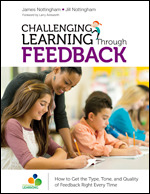Challenging Learning Through Feedback
How to Get the Type, Tone and Quality of Feedback Right Every Time
Foreword by Larry Ainsworth
Corwin Teaching Essentials
Using feedback to enhance learning
Feedback has the potential to dramatically improve student learning – if done correctly. In fact, providing
- When feedback is (and isn’t) working
- How to design feedback so that it answers three essential questions
- Strategies for crafting clear Learning Intentions and Success Criteria
- How to teach students to give
high quality feedback to themselves and others
Written by educational innovators James Nottingham and Jill Nottingham, this book is full of specific examples for educators who want to understand the qualities of excellent feedback and how to craft it.
"Feedback – a noun or a verb? A separate practice or an integral part of the learning process? Something we do ‘to students’ or ‘with students’? TheBarb Pitchford, Co-author
Leading Impact Teams: Building a Culture of Efficacy (2016)
"Finally a practical book on feedback for teachers! It is written with the teacher in mind, lesson plan in hand, and relevant to all in education. The perfect school-wide study book!"
Lisa Cebelak, Education Consultant
Grand Rapids, MI
"Not only does this book support teachers in developing a deep understanding of quality descriptive feedback, the authors give practical examples of how to design learning intentions and success criteria to lift the quality of feedback during lessons. The authors offer innovative feedback tools based on The Learning Challenge (The Learning Pit); these innovative tools will support teachers in ensuring that feedback is reliable and valid when partnering with students to create a true learning culture!"
"James Nottingham’s work on Challenging Learning is a critical element of creating Visible Learners. This new series will help teachers hone the necessary pedagogical skills of dialogue, feedback, questioning, and mindset. There’s no better resource to encourage all learners to know and maximize their impact!"
"Challenging Learning Through Feedback is an inspiring read! The authors drive home the notion that students need concrete examples to show them what success looks like for a given learning intention. I can honestly say that my own ability to use formative assessments to give quality feedback to my students has been greatly enhanced through reading it."
